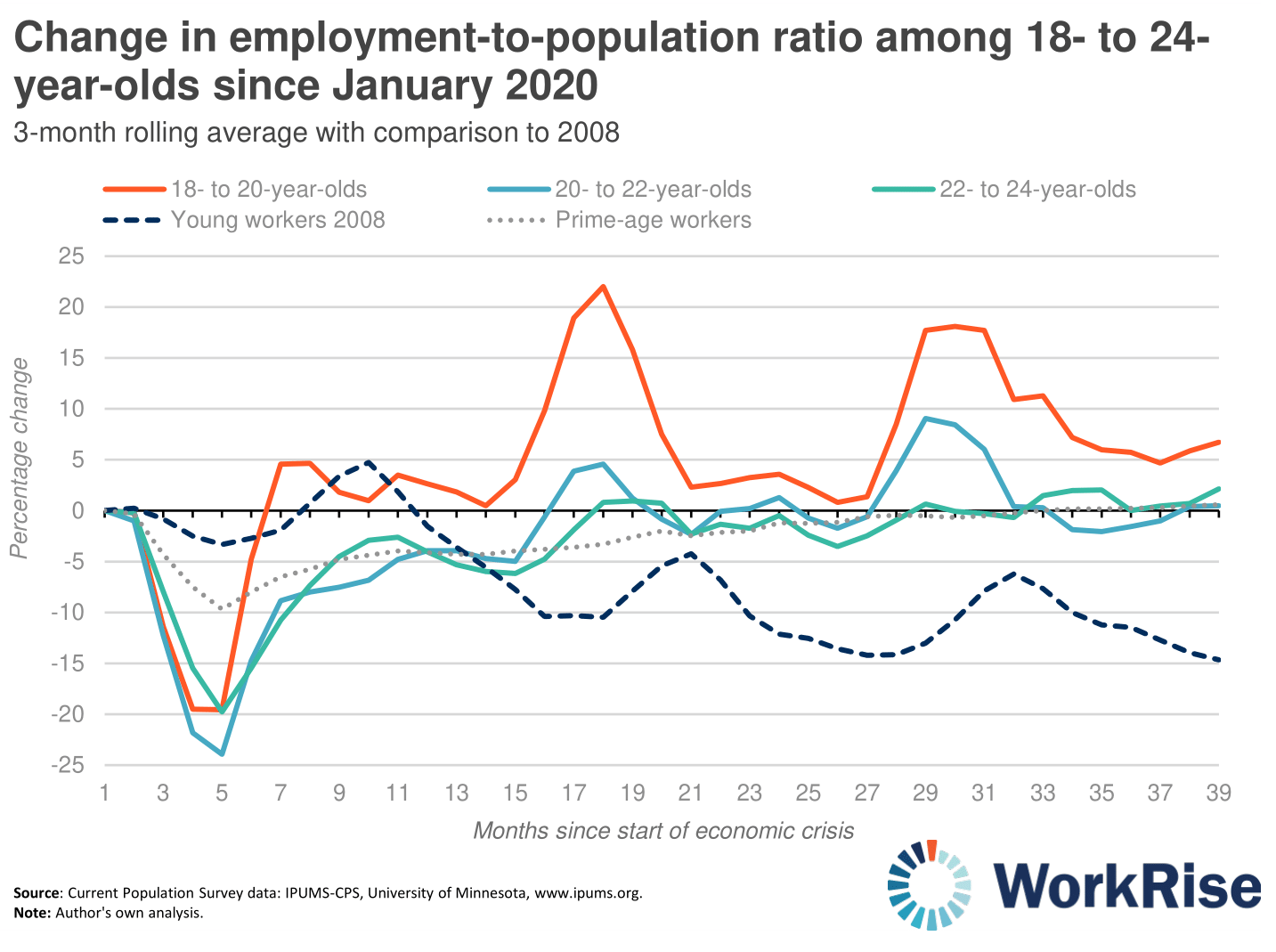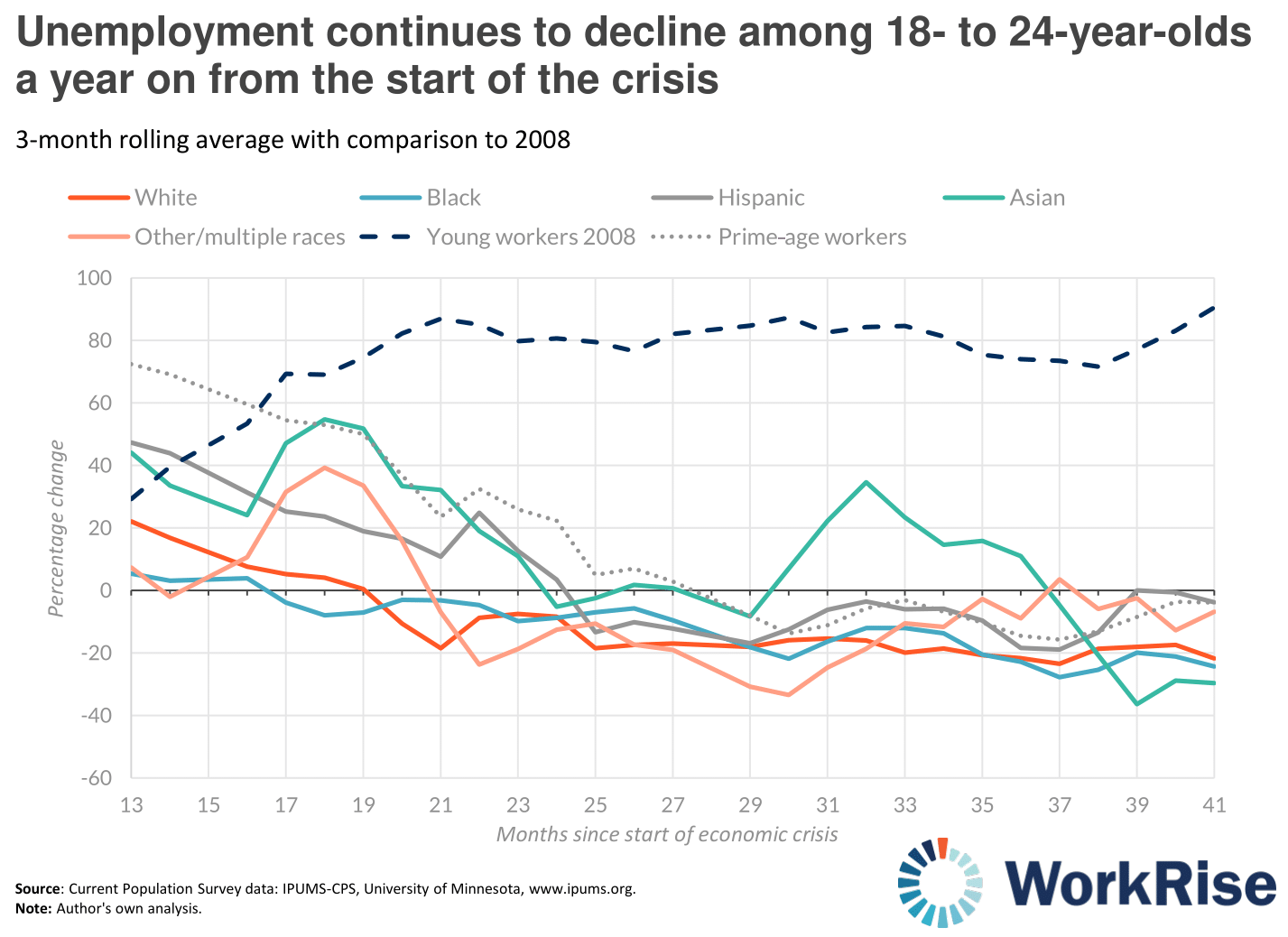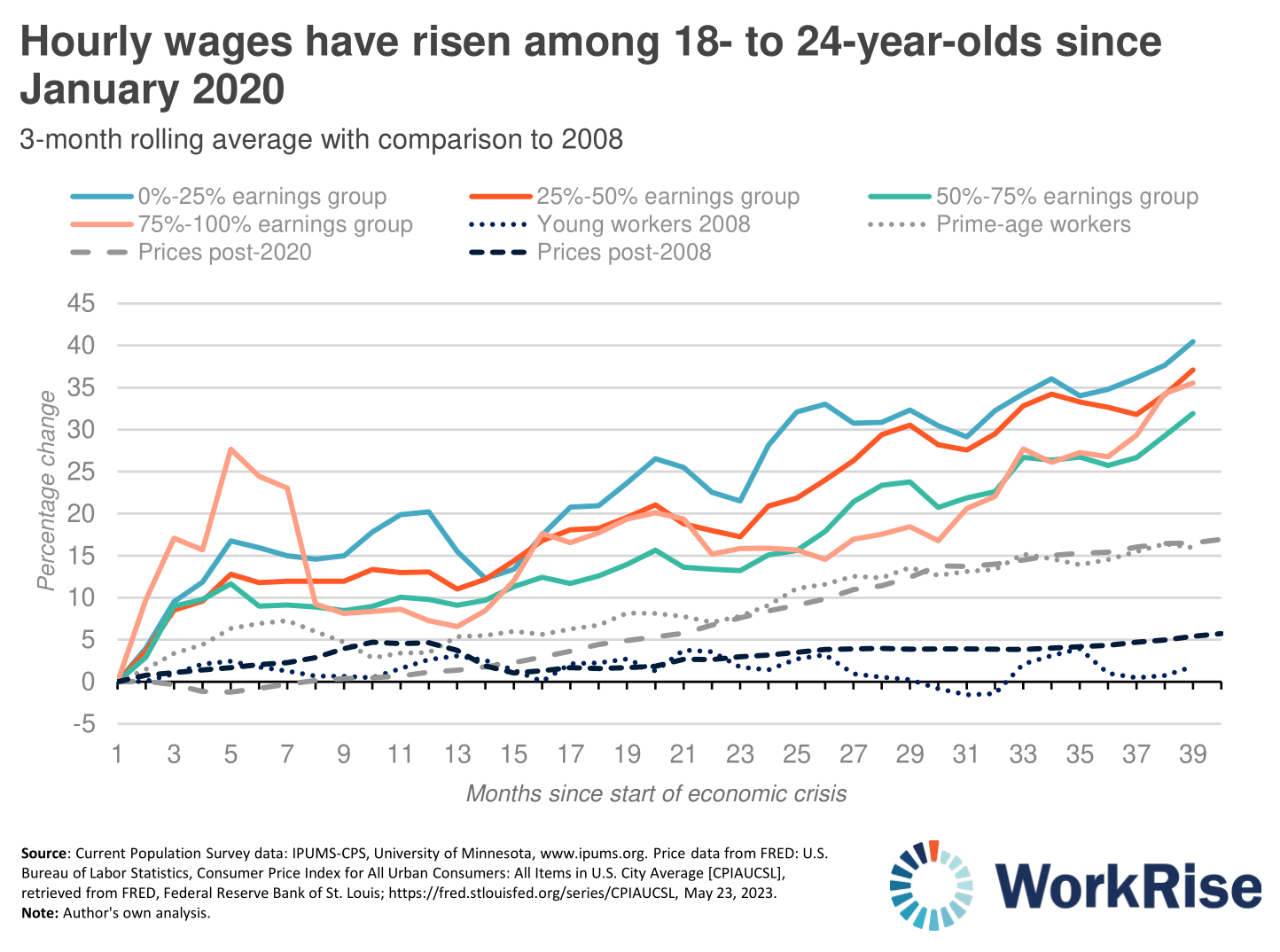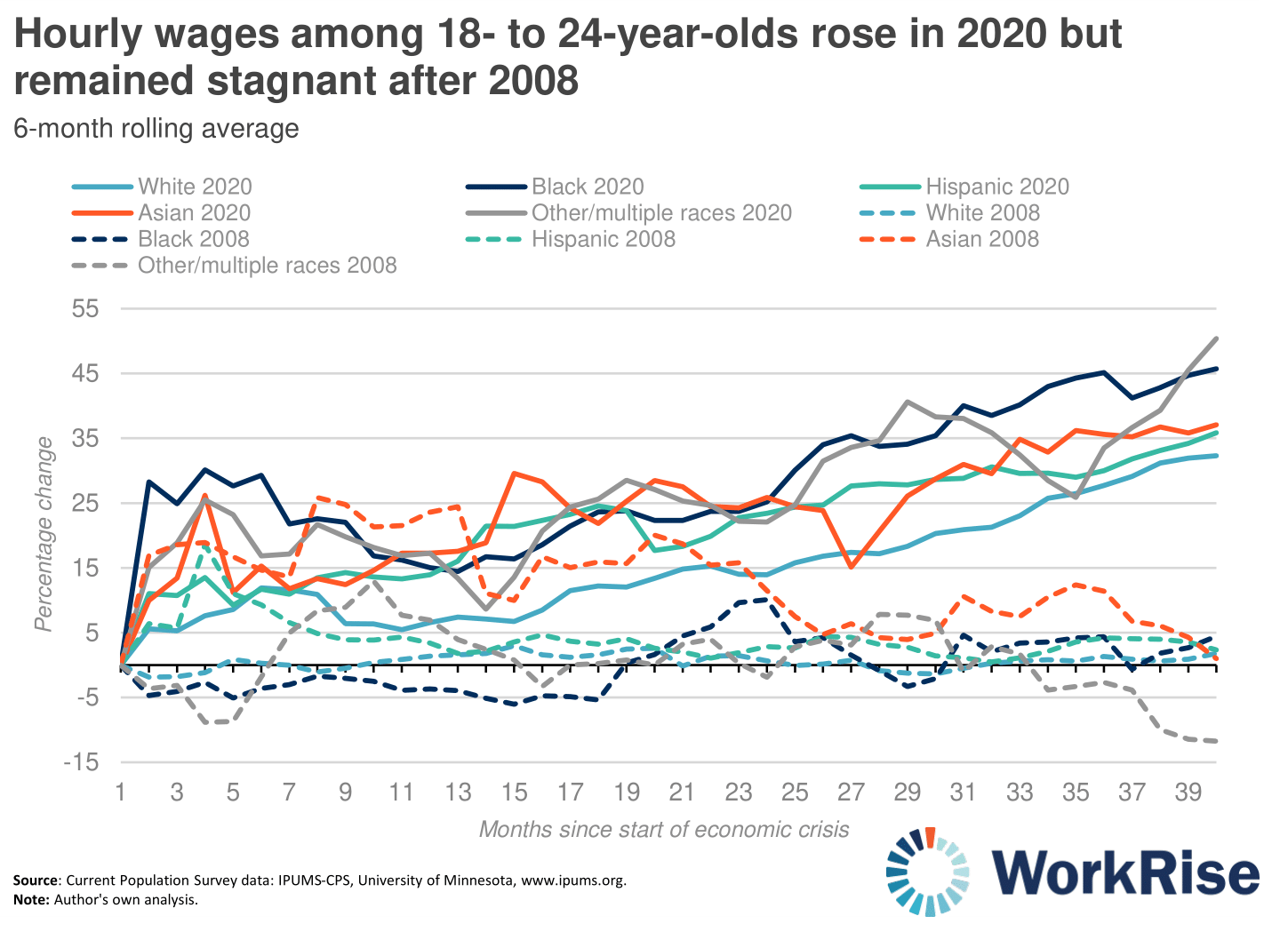In the early months of the COVID-19 pandemic, young workers stood at the precipice of a collapse in economic mobility. With their likelihood of holding jobs affected by the pandemic, young people faced a steeper spike in unemployment. And given their lower incidence of previous work history, they were also less likely to receive financial assistance through government programs like unemployment benefits. In the moment, the post-COVID-19 economic crisis threatened to mirror the 2008 recession, when young workers suffered disproportionately poor employment prospects and falling wages even years later.
Three years on from the start of the economic crisis, a rosier picture has emerged. Almost across the board, young workers have seen gains in their employment prospects and wages, signaling a sharp diversion from the trend following the 2008 economic contraction. Young working people have benefited from the increasingly tight labor market and, despite high inflation, earn more now in relative terms than before the start of the pandemic. Both trends offer policymakers lessons in how to protect this population through future economic crises and highlight where work to secure their economic mobility remains incomplete.
More young people are employed now than in January 2020

Working people between the ages of 18 and 24 have seen significant gains in their employment prospects since the onset of the COVID-19 pandemic. This segment of the workforce constitutes the age category preceding what economists’ call “prime-age” workers, who typically have the highest employment rates in the labor market. A higher share of young workers is employed now than in January 2020, outpacing the gains of prime-age workers overall. This is no small feat given that, historically, the employment prospects of young workers are the most damaged by economic downturns, whereas older workers are more likely to be shielded from the most serious harms of economic crises.
As a rule, variation in employment is more pronounced among the youngest workers, who are less likely to be in full-time employment and are more likely to take summer jobs (hence the peaks for 18- to 20-year-olds in July 2021 and July 2022). Nevertheless, employment has been consistently higher for these workers in every season since the summer of 2020. For workers between the ages of 20 and 24, the employment gains post-COVID-19 have been subtler than for those aged 18 to 20 but remain positive.
This trend marks a stronger and more rapid recovery than the upturn that followed the Great Recession in 2008, when young workers bore the brunt of persistently low employment. Forty months after the start of the 2008 crash, the share of young workers employed continued to shrink, having already contracted by 15 percent since the onset of the crisis. By comparison, employment growth for young workers post-COVID19 has not only been strong on its own terms, but it has also been a remarkable improvement on the last economic crisis.
Similarly, the share of young people looking for work has decreased across the board

The strength of the current economic recovery is starkly obvious in the unemployment rate, measured by the share of workers in the labor force who are actively looking for a job. The unemployment rate nearly doubled between October 2007 and January 2011, yet the unemployment rate has fallen for young workers over the same period post-2020.
In the immediate onset of the COVID-19 crisis, Asian workers faced the highest proportional increase in unemployment (in part because they disproportionately lived in hard-hit areas like New York City and San Francisco). In the time since, young Black and Asian workers have seen a greater drop in unemployment than other racial groups, offering a glimmer of hope for efforts to advance racial equity in employment prospects among America’s young workforce.
Nevertheless, the economic recovery has been imperfectly shared. Young Latinx workers, while experiencing a similar drop in unemployment as the prime-age workforce overall, have not gained as much in this recovery as white workers. With unemployment among young Latinx workers standing at 8.8 percent, higher than the 6.2 percent unemployment rate of young white workers, the challenge for policymakers to propel employment for these groups remains. While these trends have reduced inequality, this has only dented the persistent unemployment gap between young white and Black workers. The unemployment rate among young Black workers, for example, stands at 11.9 percent, nearly twice that of white workers. Policymakers should examine the lessons of the COVID-19 recovery to eradicate this gap altogether.
As employment has gone up, so have wages

One significant byproduct of the increasingly tight labor market is that as unemployment has fallen, wages have risen. For prime-age workers, wages have risen consistently since 2020, keeping up with higher prices (as reflected in the inflation rate). Research indicates that the lowest paid workers have been the greatest beneficiary of these gains, helping to shield the most vulnerable from the higher cost of living.
Young workers, who tend to be less well paid than prime-age workers, have benefited considerably from this trend. Wages are anywhere between 30 and 50 percent higher for young workers depending on their earnings percentile, in every case higher than the 17 percent rise in prices over the past 40 months.
As unemployment continues to fall, employers must compete harder for a smaller pool of potential employees. Consequently, young workers are offered (and receive) more generous wages. The greatest beneficiaries of this trend among the young workforce have been those in the lowest wage quartile, who have seen a 40 percent increase in their wages since January 2020, far and above inflation over the same period. The strength in this economic recovery, as compared with 2008, is that not only are average wages rising but the floor is rising as well, protecting the most economically vulnerable. Economic mobility for the lowest earning workers was severely hurt during the Great Recession, when young workers were paid less in both absolute and relative terms. Despite the short but major economic contraction in 2020, young workers today have not faced the same fate.
Wage growth has been particularly strong for young workers of color

Mirroring the trend of the lowest paid young workers seeing the greatest wage growth, so too have the most marginalized young workers seen substantial gains in their paychecks. Black, Latinx, and Asian, and other young workers of color have all seen stronger wage growth than young white workers. Young Latinx workers, too, who have not seen a similar drop in unemployment as their white, Black, and Asian contemporaries, have nevertheless seen a stronger growth in wages than young white workers.
Although young workers of color still earn less, this trend suggests progress in the fight to lessen race-based income divides among the young. This may also portend a positive direction for racial income divides in the future, as the wages of young workers tend to predict their pay as they grow older. These are all positive signs even though there remains considerable work to advance racial equity.
It is important that the post-2020 recovery has proved significantly different from the experience of 2008. Not only have workers seen absolute and relative gains in their wages, but these gains have also been strong and consistent. This is critical as previous evidence has shown that those who graduate during an economic downturn earn less even decades on. Following the 2008 recession, young workers experienced stagnant wage growth for at least a decade. Similarly, the prospect of employment for younger workers remained severely damaged even years later.
This time, young workers have not lost wages or jobs. In fact, the labor market currently offers young workers better employment and job prospects than even before the pandemic, when the economy was strong on its own terms.
Evidence suggests that greater federal stimulus following an economic contraction facilitates a speedier recovery and therefore a more rapid increase in employment. While more research is needed into the exact processes that encouraged such a strong rebound post-2020 (an unprecedented economic shock), the situation for young workers indicates that the public interventions in both 2020 and 2021 helped reinforce the employment and earnings situation of young workers. The mistakes of the post-2008 recovery, it seems, were duly avoided.
The success of this recovery relative to previous downturns also highlights where work that is yet to be done. Even though employment and wage growth has been strongest for the most marginalized workers, the path toward racial equity remains incomplete. That the past 40 months have been more equalizing than other episodes in recent history offers policymakers a clear success story from which lessons can be learned and built on—beyond times of economic crisis.